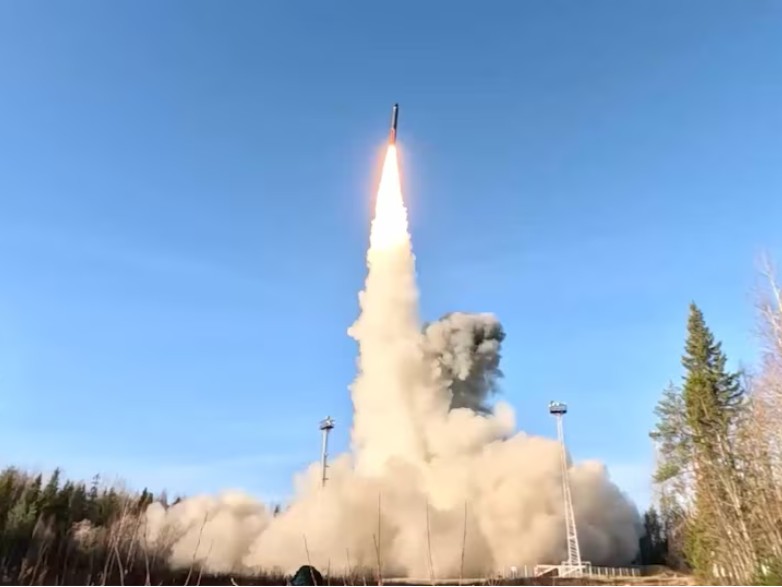“I hated to do it, but had no choice! Because of other countries’ testing programs, I have instructed the Department of War to start testing our nuclear weapons on an equal basis. That process will begin immediately,” said President Donald Trump on his Truth Social just before his scheduled meeting with the President of China, Xi Jinping, at Busan, South Korea.
In effect, President Trump has reversed a long-standing no-testing policy of the United States put in place by President George Herbert Walker Bush in 1992.
A day before President Trump’s announcement, Moscow said that it had successfully tested a nuclear-capable and nuclear-powered underwater drone, the Poseidon. This followed a much-publicized test of another advanced nuclear-capable weapon called the Burevestnik cruise missile of “unlimited range.”
What caught the attention of many is that the underwater Poseidon drone, launched from submarines, could travel from the Russian East Coast to the American West Coast, thereby ushering in a new dimension to the already fragile moratorium on nuclear weapons. In raising the hype, few differentiated between testing systems capable of delivery and actually testing a nuclear weapon.
Nevertheless, the hand-wringing has begun, even if few are able to suggest ways of getting out of this tense situation. In a span of eighty years, the international system has seen different stages of this nuclear madness—from the July 1945 test in New Mexico by the United States; the first use of atomic bombs on Hiroshima and Nagasaki in August 1945, ostensibly to end the Second World War; and, four years later, the then–Soviet Union carrying out its maiden nuclear test code-named First Lightning. Britain, France, and China joined the Nuclear Club in 1952, 1960, and 1964, in that order.
Since the Comprehensive Test Ban Treaty of 1996, which banned all nuclear test explosions for civilian and military purposes, India and Pakistan tested in 1998, and North Korea is said to have conducted multiple tests between 2006 and 2016. The only exception is Israel, which is generally believed to possess nuclear weapons.
According to the Arms Control Association, the nine nuclear powers hold a combined total of 12,400 nuclear warheads, nearly 90 percent in the hands of the United States and Russia. The numbers may not be precise, but it is generally believed that Russia has 5,580 warheads, followed by the United States with 5,225 and China coming in a distant third with 600. Of the remaining nukes, some 350 are believed to be held by India and Pakistan.
In the context of what is happening between Russia and Ukraine, there has already been a nuclear scare in Europe about the potential of someone doing the unthinkable. Closer to South Asia, anytime tensions flare up between India and Pakistan as a result of cross-border terrorism, there is always anxiety that the conflict could spiral out of control, with the potential for a nuclear exchange.
But what is happening now, in the aftermath of President Trump’s announcement, is a fear that the international system is slowly returning to the days of the Cold War, with Moscow and Beijing making their own announcements, and in the process setting off an accelerated arms race that will be detrimental to the whole world. It is pointed out that, irrespective of how a test is conducted on the ground, underground, or at ocean floors—there is a huge risk of radioactive fallout and the poisoning of groundwater resources.
In the aftermath of what has been seen as a successful summit meeting between Presidents Trump and Xi in South Korea, Beijing did not fail to address the subject of nuclear weapons, urging and hoping that Washington will follow global consensus. “China hopes the United States will earnestly abide by the obligations of the Comprehensive Nuclear-Test-Ban Treaty and its commitment to a ban on nuclear testing, and take concrete actions to safeguard the global nuclear disarmament and non-proliferation system and safeguard global strategic balance and stability,” Foreign Ministry Spokesman Guo Jiakun was quoted as saying in an agency report.
There is yet another scenario to the unfolding scheme of things: the thinking of the nuclear “wannabes,” and whether this would provide a cover to break out and resume their programs under the pretext of the major powers themselves not subscribing to established treaties and protocols. It is not just about what Iran would do under the circumstances but also about a host of other countries in the Middle East and Asia that have had their eyes and ears perked up for quite some time, for one reason or another, and, in the process, setting in motion a perfect template for rising regional tensions.
Disclaimer: The opinions and views expressed in this article/column are those of the author(s) and do not necessarily reflect the views or positions of South Asian Herald.






